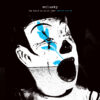M Ross Perkins is a psychedelic songwriter from Dayton, Ohio. On the cover of his third album What’s the Matter, M Ross?, he sits on a stool, surrounded by bouquets of flowers, and he holds a copy of his own album like a geography teacher showing and telling a class how to show and tell. Or a philosopher in a televised debate in the 1970s presenting evidence of society’s slide into decadent oblivion. You have a sneaky suspicion that this fella M Ross Perkins is a bit of a wind-up merchant.
But what about the music? Within 20 seconds of the album’s lead track ‘Hey Man/Hey Self’, you’ll be imagining yourself threading daisies through your hair and flapping Kate-Bush-Wuthering-Heights-style in a gossamer dress on your way to the festival. It would be incredibly lazy to describe the track as ‘Paul McCartney fronting The Byrds’, but it would also be absolutely accurate.
‘Saccade I’ is slow surf guitar and excerpts of conversations from young and anxious Americans. “What’s the matter with him?” some of them ask in unison. It’s like the band in Back To The Future taking a back seat while giving the mic to a group huddle on the dancefloor. I don’t know what the B-side to ‘I Want To Hold Your Hand’ is, so I’ll just pretend it’s ‘Gone (In The Morning)’. The jangly arpeggios and layered vocals on next track ‘Crying in My Sleep’ are reminiscent of Rhode Islanders The Low Anthem.
Mathew Street, Liverpool, 1962. What’s that thrilling noise emanating from underground? It’s ‘Spiritual Kick’ by M Ross Perkins. “What’s the matter with him?” the young Americans ask again on ‘Saccade II’ (the Back To The Future band have been replaced by The Doors). “He is disappointed in the human race,” someone replies. “He seems like he’s like not genuinely troubled, but like he’s posing to look like he’s troubled.” See? Wind-up merchant, finding refuge in a dimly-lit venue in late 60s Greenwich Village.
“I used to wear a lot of clothes that did not fit,” ruminates Harry Nilsson – sorry, I mean M Ross Perkins – on ‘I Feel So Dumb’, which has echoes of Richard Hawley. The bossa nova rhythm might make you book dancing lessons at your local village hall. ‘I Don’t Wanna Be So High’ is both a glam stomp and a rueful account of how it feels the morning after the festival.

‘Saccade III’ is another collage of vocal snippets, just over a minute long. A concerned friend says, “He’s definitely overweight. Whether he cares or not, you can’t really tell…” Teenage Fanclub channelling early Beatles equals ‘Baby, My Bad’. ‘A Date For One’ is a beautiful acoustic entreaty to spend time alone and “have a cup of tea.” It has the warmth and vulnerability of Jason McNiff’s cover of ‘Tomorrow Never Knows’ and the melancholy of Sea Change-era Beck.
‘That’s Fine’ is the comedown after Free’s ‘Alright Now’. ‘Bouquet’ is John Lennon fronting Pink Floyd. On ‘Saccade IV (Plastic in the Face of Mind)’ the Back to The Future band make another low tempo appearance while people from different nations also wonder what the matter is. ‘Quite Rightly Kindly’ is an everyone-on-the-dancefloor hoedown that could have been written by Marc Bolan and Paul Rodgers.
What is the matter with M Ross Perkins? Based on What’s the Matter, M Ross?, it would seem that he has several comorbid conditions: reverent nostalgia, self-deprecating humour, and a heavenly gift for melody. As someone once said: rock is for geologists and pop is for thirsty kids. With his new album, M Ross Perkins satisfies both the stone enthusiasts and the parched children. That said, if you’re indifferent about Earth’s foundations and you’re 18 or over, you’ll still be delighted by his latest batch of psychedelic treats.
What’s the Matter, M Ross? is out now on Colemine Records




